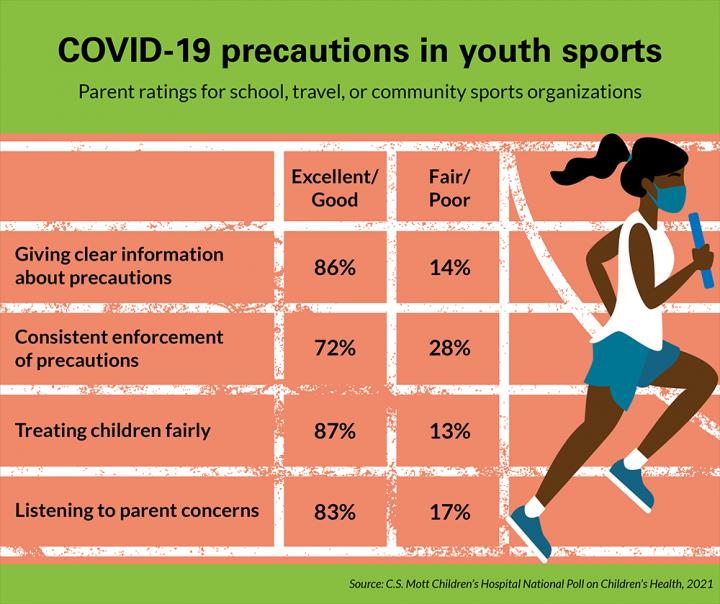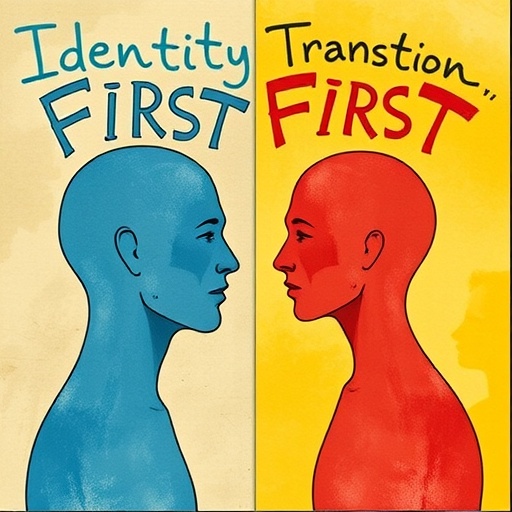The majority of parents feel informed and confident about pandemic protocols as kids resume sports but some are proceeding with caution

Credit: C.S. Mott Children’s Hospital National Poll on Children’s Health at the University of Michigan.
ANN ARBOR, Mich. — For young athletes, the new normal on soccer fields and basketball courts means temperature checks before practice, wearing masks through games and a sparse in-person fan base.
But that hasn’t kept children and teens from playing. Close to a fourth of parents say their child has participated in school, travel, or community sports during the fall or winter months, according to the C.S. Mott Children’s Hospital National Poll on Children’s Health at the University of Michigan.
And while the majority of parents give their child’s sports organization high marks for communication about safety protocols, one in four rate their sports league as fair or poor for consistent enforcement of COVID-19 precautions.
“As kids return to playing sports, it’s critical that teams and facilities enforce COVID guidelines to keep players, coaches and families as safe as possible and to reduce community spread,” says poll co-director Sarah Clark, M.P.H.
“This is especially important as we have seen recent COVID-19 outbreaks among youth sports teams. While most families seem confident in their local organization’s safety measures, our report suggests that ensuring compliance with COVID-19 protocols has also been challenging.”
The nationally representative report comes just as health experts say team sports may be a big driver of youth COVID-19 cases. The nation’s top infectious disease expert, Anthony Fauci, M.D., said this month that recent school cases have frequently been traced back to sports.
Local health departments in several states, including Florida and Minnesota, have also traced outbreaks back to youth sports. In Michigan, where COVID-19 cases have surged, experts attribute recent outbreaks among young people to extracurricular activities that involve kids spending long periods of time together, rather than classroom exposure. Socialization before and after sports events, including indoor, mask-less gatherings, may also be contributing to the spike in cases among young people.
The trends have led to many schools again putting a pause on sports seasons and returning to virtual learning.
Playing in a Pandemic
The Mott Poll report is based on responses from 1,630 parents of children ages 6-18 who were surveyed about youth sports participation between August 2020 and January 2021.
Sports participation was slightly higher for older children 12-18 years compared to younger children 6-11 years (25% vs 21%), the Mott Poll report finds. Among parents whose child did not participate in a sport, one in three parents said their child’s sport was canceled, while one in four wouldn’t allow their child to participate due to COVID-related safety concerns.
Overall, three in four parents felt their child’s sports team mostly got it right when it came to resuming sports during COVID. Roughly equal numbers of parents felt officials were too strict versus too lenient (13% compared to 14%).
The majority of parents also gave excellent or good ratings to their child’s school or sports league for clear communication, treating children fairly and listening to parent concerns about COVID-19.
Among parents whose child participated in one or more sports, more than 90 % say they received information from the school or sports league about masks and social distancing guidelines for players and spectators.
Four out of five parents also received information about when players should sit out of practice or games after being exposed to the virus and the same percent also felt informed on when a child could return to play after a COVID-19 diagnosis.
Rules on testing guidelines, however, were sometimes less clear, with only 59% of parents seeing communication regarding when players should get tested for COVID-19.
“Parents largely felt that sports officials successfully communicated about most of their new COVID-19 policies,” Clark says.
“Communication was notably lower around COVID-19 testing. It’s unclear if the lack of information was an oversight or if schools and leagues didn’t have clear guidelines from public health officials.”
“As more youth sports resume, our poll suggests that parents will need further direction on whether, when and where their child should get tested. This is particularly important as cases are rising among younger people.”
When a child can return to sports activity after a case of COVID-19 is another key decision facing parents. When asked what they would likely do if their own child had COVID-19 during a sports season, 40% of parents would wait the number of days specified by team or league guidelines, while half would have their child cleared to play by a doctor. Five percent would base the decision on when the child felt well enough to play.
More parents of older than younger children would wait the specified number of days (46% vs 33%), and fewer parents of teens would have their child cleared by a doctor (44% vs 57%).
Experts say that return to play should be based on the severity of the infection, whether there’s a pre-existing medical condition, and if the child is experiencing ongoing fatigue, fever, dizziness or chest pain.
“If parents rely solely on league guidelines to determine when it’s safe for their child to return to sports activity, they may overlook signs that the child is not fully recovered. It’s important that parents involve their child’s doctor for specific guidance on resuming sports activity,” Clark says.
In addition to school or league policies, parents should also reinforce common sense steps such as not sharing water bottles or food, and using hand sanitizer during breaks in activity, Clark says. They should also consider their own actions, such as maintaining social distance and wearing masks while attending games.
Players and families should also avoid indoor gatherings before and after sporting events, especially with unvaccinated groups.
“We know sports provide physical and social health benefits for children and teens and are a valuable part of many students’ school experience,” Clark says.
“Unlike many youth activities that have switched to a remote format to meet social distancing guidelines, sports can’t go virtual. It’s important that both sports officials and families closely adhere to guidelines that minimize the risk of COVID-19 transmission during practices and competitions.”
###
Media Contact
Beata Mostafavi
[email protected]




